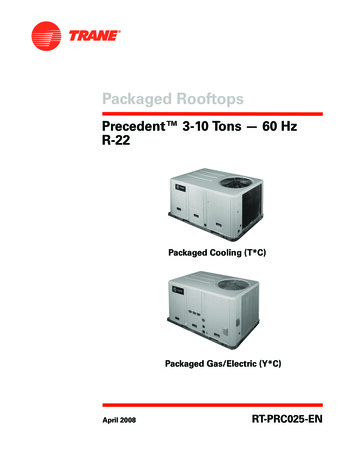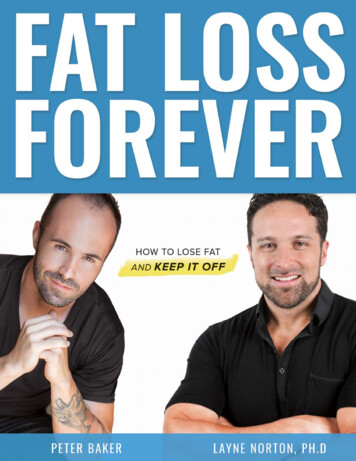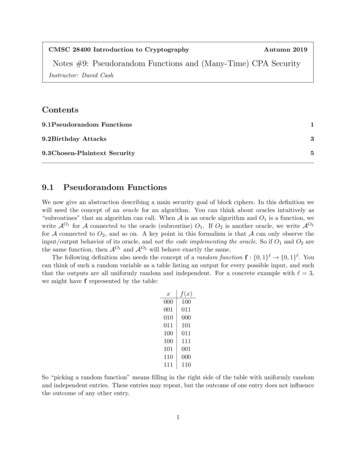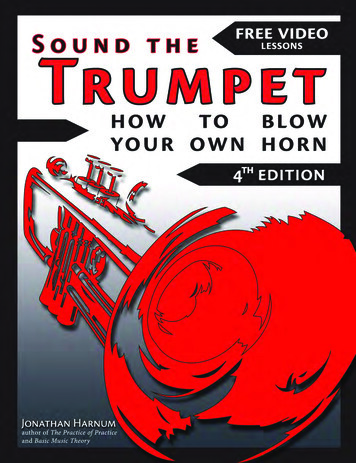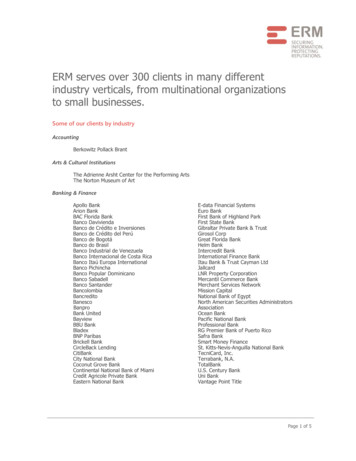
Transcription
1Chapter TwoSEVERAL ELECTRIC "VIOLINS"The Violin as Meta-instrumentNow he hit hard and clean on the notes, the double-stops true, a kind of goatish leap in hisplaying that had never been there before, that cooked out as a raw and slangy sound. Dolor wasgetting good music out of the box, rich and competent, despite the bad speakers, a yard ahead ofhis usual cut. The dancers were pulling the music out of them. People were dancing, bumping thestove, the table, the kitchen floor was undulating, Mrs. Bubbie was washing the dishes andslapping the clean plates into the drain rack, they were dancing through the door and into thebackyard, when somebody slammed the refrigerator door and the speaker rolled off, bouncingfrom Mrs. Bubbie's shoulder into the dishwater where it simultaneously broke, exploded andloosed a savage current that raised the birthday girl's hair in a crest and threw her, staggering,into the crowd of dancers.from Accordian Crimes, by E. Annie Proulx.1A SuperclassAt some point in their lives, most violinists are asked a seemingly simplequestion: what is the difference between a violin and a fiddle?2 As an electricviolinist, I have also been asked: what makes an electric violin a violin? The shortanswer to both of these questions is the same: the way the instruments are playeddefines both their differences and their similarities. These questions reflect imagesof the instruments, their music, and their social contexts. The three (unscaled)pictures below, of a "Classical" violin, a "fiddle," and an electric "violin" tell onlypart of the story:1 E. Annie Proulx, Accordian Crimes (New York: Simon and Schuster, 1996), 201.2This question usually refers to some nebulous ill-defined creature that may be Bluegrass, Irish, Gypsy, or anynumber of other fiddle styles.
2Figure 1. A "Classical" violin, a "fiddle" and an electric "violin"3The visual differences between violin and fiddle are hardly obvious. In design theyare essentially identical; the primary difference lies in the choice ofstrings—fiddlers often choose steel strings for greater penetration. The electricviolin, on the other hand, is so different that it is not immediately identifiable as aviolin. The following pictures, with these instruments in the hands of their players,tell a different story:Figure 2. Anne Sophie Mutter, Bruce Molsky, and Mark Wood4Put to use, all three become "violins"—of sorts.The broad visual image of these players defines them all as "violinists" andtheir instruments as "violins." The details give us an idea of their differences. In this3Image of "Classical" violin from http://www.silcom.com/ craig/anne-sophie/anne-sophie.html; image of "fiddle"from l; image of electric fromhttp://www.moseisley.com/mw/wvhp.html.4Image of Mutter from http://www.silcom.com/ craig/anne-sophie/anne-sophie.html; image of Molsky .html; image of Wood from http://www.moseisley.com/mw/.
3sense, I regard the "violin" as an instrumental archetype—a superclass, or metainstrument—that specifies little about the instrument and nothing about the music itis used to play (or its sound!). The "violin" is a bowed string instrument. Its stringsare 32cm in length, give or take a few centimeters, and the bow is usually about72cm long. It is held above the (left) shoulder. One hand draws the bow across thestrings while the other depresses the strings at certain points. That's about it. Onecould get picky and imagine an instrument designed to be played upside down yetstill satisfying all these criteria, but my archetype is a fuzzy archetype with loose,incomplete criteria, and it includes—indeed, is centered around—the visualimage—a physical posture—of how the instrument is played. The three picturesabove all satisfy this image, and show that the look of the player is more importantthan the look of the instrument. One might then argue that I need not specify stringand bow length, but these are essential to transparency of technique; anyone withtraining on any subclass of the violin should be able to bring much of her years ofphysical training to bear in another subclass—grossly altering either of theselengths can reduce the seasoned professional to near beginner.5The fiddle, then, is a specific subclass of the violin that inherits the propertiesof the superclass and adds several of its own. Likewise for the "Classical" violinand the electric violin. These include further subclasses, like Corelli's violin,Schubert's violin, and Bartók's violin (for the "Classical" violin), or the Bluegrassfiddle, the Irish fiddle, and the Hardanger fiddle. Each of these subclasses isinherited and brought to life by players, and there may be significant overlap amongthem. Matt Molsky's violin represents an idiosyncratic instance, a realizedpotential, of the violin, as do those of Anne Sophie Mutter and Mark Wood. Tofully describe the differences between a "Classical" violin and a (particular) fiddlewould require a critical inquiry similar to that of Chapter 1.Part of my reason for developing the notion of violin as superclass is toprovide a broader context for considering approaches to the electric violin, the"violin's" newest subclass. The violin, both grossly and specifically, is defined bythe way it is played. Learning to play any of the particular instances of the violinrequires a deep investment in time, energy, and physical training. The things that aviolinist teaches his body to do in order to play one kind of violin will, on one level,make it easier to adapt another, but they may also stand in the way. Ask any"Classical" violinist who has decided later in life to learn a fiddle style, and she willtell you about the "retraining" that needs to happen; technique needs to berelearned. 6 A more telling example is the violinist who was trained on a Modernviolin (like Schubert's and Bartók's) and decides later to play an "authentic" violin(like Corelli's); although he may be playing the same music, he has to make5So much of an instrumentalist's training involves teaching the muscles where to put the fingers; it is this kind oftraining that is so difficult to redo, and also why a violinist will have an easier time picking up viola than cello. Thethree instruments pictured above have essentially identical string and bow lengths.6This can happen among "Classical" violinists even when they simply switch teachers.
4significant adjustments in his technique in order to play the "new" instrument. As Idescribed in Chapter 1, these differences in instrument design intertwine with theexpressive nature of the music that is written for them, and by extension, thephysical training required by its player; we can see clearly that the music andexpressive intents of Mutter and Molsky differ significantly by their pictures alone.When a violinist of a particular ilk decides to take up different violin, sheusually is familiar with, and attracted to, certain aspects of the new violin—itsmusic, its social context—and willing to go through the retraining necessary to playit. Even then, the retraining can sometimes prove more involved than anticipatedand discourage the potential convert. For example, after several years of trying, Ifinally gave up trying to play "jazz" violin, mostly because I was unable to developa way to "swing" with the bow that was satisfying. Swinging with a bowedinstrument is a tough nut to crack, but it has been done—Stephane Grappelli andStuff Smith are great examples. Absorbing their articulative bow styles is a lifetimeendeavor, however, and for a variety of reasons I decided to move on. The problem,however, was with me, not with my violin or with "jazz."Now, imagine our convert picking up an electric violin. In comparison to anyother violin, the electric violin has virtually no music and no social context. This iscompounded by the fact that it is physically very different from any other violin. Itis a vast reservoir of undeveloped potential, and as a result it lacks the models andtraditions that are so rich for other violins. Our convert has no choice but to use herown models as a starting point, and if she is not adventurous and at least asdetermined as I was to learn jazz, she will be disappointed by the incongruitybetween her technique and the instrument. "It doesn't feel right," she will say, or"it's not as sensitive as my Guadagnini." She is right, but it's a bit like a violinistpicking up a viola and complaining that it's too big and that the strings are tuned allwrong. Just because you can basically play the instrument—they both fit the"violin" archetype after all—doesn't mean you can really play the instrument. Andbecause there is no Stephane Grapelli of the electric violin, no icon to strivetowards, no evidence that the instrument is worth retraining for, she is likely to putit away and label it an inferior instrument.7I believe that the electric violin is one of the most wonderful subclasses of theviolin yet to emerge. In the rest of this chapter, I will explore what differentiates theelectric violin from other violins. I am particularly interested in discovering thoseproperties of the electric violin that change the way players go about the physicalactivity of playing. Just as lengthening the neck and increasing the tension of the"Classical" violin in the late 18th-century allowed—indeed, forced—players toengage the instrument with more weight, and hence provided a natural vehicle forSchubert to compose his "weighty" music, amplifying the violin must reinvent the7This has happened to me several times when I've shown my instruments to other violinists, so this is nothypothetical. Another problem is that, as with acoustic instruments, there is a wide range in electric violin qualitiesand styles, and it can take years of searching before finding the "right" one.
5way the violinist plays. This is in part a call to action. The potentials of the violinwill never be realized if violinists don't make the effort to look for them. Corellidedicated his entire compositional career to the violin, and his music continues todemonstrate many of the great strengths of the instrument. As Tracy Silverman(formerly of the Turtle Island String Quartet and one of the current champions ofthe electric violin) said to me: "We've got to show people what these things cando!"8Deconstructing the Violin:The Player-Instrument Feedback LoopThe electric violin, as a subclass of the violin, requires but one specialproperty; its sound must be electrically amplified. If the primary motivation foracoustical developments in violin design was to increase volume and projection, itwould seem that electrical amplification is the ultimate solution. Indeed, one of thegreat pleasures of the electric violin is that it allows the player to compete finallywith other loud instruments; for so long, violinists have struggled to project overorchestras in large halls, and fiddlers have nearly sawed their instruments in twotrying to be heard over drums and dancers. If electrical amplification were a simpleextension—a "scaling" mechanism—of the wooden amplifiers (i.e., the resonatingbodies) that constitute the violins described in Chapter 1, we would wonder whyevery concert violinist doesn't plug in when playing the Brahms Violin Concerto. Itis not so simple, however, and Anne Sophie Mutter continues to rely on her woodenamplifier in Avery Fisher Hall.9 On the other hand, electrical amplification haspenetrated virtually every other performance context for the violin, even the"Classical" concert hall with groups such as the Kronos Quartet. How doeselectrical amplification change the violinist in these contexts? How does it affectour conception, as listeners and composers, of the violin? Which potentials are lost,or gained, and why? How does amplification change the expressive capabilities ofthe violin?The first thing a violinist notices when playing electric is that the primarysound source is no longer directly under the ear.10 This sense of detachment can beat once both empowering and distressing. Freed from the limits of the box that fitson our shoulder and projects squarely into our ear, we can turn the volume up andpoint the amplifier at our electric guitarist friend, deafening him with gruesomeponticello. On the other hand, there is a striking loss of intimacy, even with a smallamplifier placed nearby. What was once a voice whispering in our ear becomes a8Personal correspondance.9It is interesting that in the "Classical" guitar world, soloists frequently rely on amplification in concerto andchamber music contexts.10Unless she is playing through headphones, which can be equally disorienting.
6remote presence, no longer seeming part of our body.11 This separation can also bedisconcerting for the listener. Part of the voice-like character of the violin is theresult of the proximity of the violin's point of projection to the mouth. When we seea violinist pull the bow across the string and hear the sound coming from a speaker(or multiple speakers) that may be many feet from the player, there is a definitesense of disconnectedness. This is the standard mode of operation with the organ,but with the violin, whose voice-like and visual-gestural qualities are so important,it is unfamiliar.On the other hand, detachment can minimize the differences in sound that theplayer and listener perceive. "Classical" violinists are trained to "project" theirsound, which can result in the violin sounding harsh and unpleasant under the ear,but strong and full in the back of a large hall. With an electric violin, we have theoption of "projecting" by simply placing a speaker in the back of the hall, or insome other configuration between listener and player. Since high frequencies tendto be attenuated more quickly over distance than low frequencies, the listenerusually hears some kind of "low-passed" version of the tone the player hears underher ear
Now, imagine our convert picking up an electric violin. In comparison to any other violin, the electric violin has virtually no music and no social context. This is compounded by the fact that it is physically very different from any other violin. It is a vast reservoir of undeveloped potential, and as


